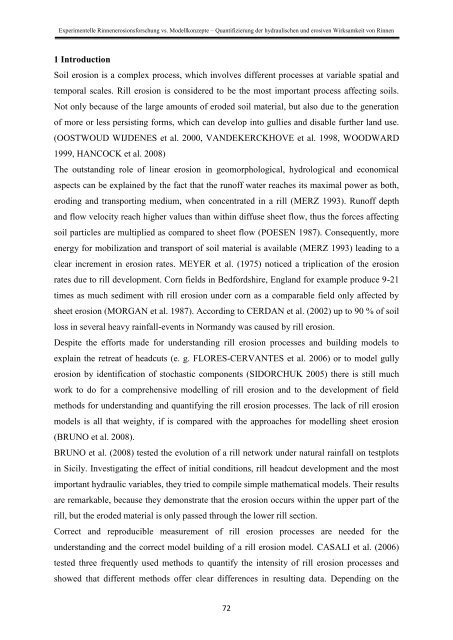Stefan Wirtz Vom Fachbereich VI (Geographie/Geowissenschaften ...
Stefan Wirtz Vom Fachbereich VI (Geographie/Geowissenschaften ...
Stefan Wirtz Vom Fachbereich VI (Geographie/Geowissenschaften ...
Create successful ePaper yourself
Turn your PDF publications into a flip-book with our unique Google optimized e-Paper software.
Experimentelle Rinnenerosionsforschung vs. Modellkonzepte – Quantifizierung der hydraulischen und erosiven Wirksamkeit von Rinnen<br />
1 Introduction<br />
Soil erosion is a complex process, which involves different processes at variable spatial and<br />
temporal scales. Rill erosion is considered to be the most important process affecting soils.<br />
Not only because of the large amounts of eroded soil material, but also due to the generation<br />
of more or less persisting forms, which can develop into gullies and disable further land use.<br />
(OOSTWOUD WIJDENES et al. 2000, VANDEKERCKHOVE et al. 1998, WOODWARD<br />
1999, HANCOCK et al. 2008)<br />
The outstanding role of linear erosion in geomorphological, hydrological and economical<br />
aspects can be explained by the fact that the runoff water reaches its maximal power as both,<br />
eroding and transporting medium, when concentrated in a rill (MERZ 1993). Runoff depth<br />
and flow velocity reach higher values than within diffuse sheet flow, thus the forces affecting<br />
soil particles are multiplied as compared to sheet flow (POESEN 1987). Consequently, more<br />
energy for mobilization and transport of soil material is available (MERZ 1993) leading to a<br />
clear increment in erosion rates. MEYER et al. (1975) noticed a triplication of the erosion<br />
rates due to rill development. Corn fields in Bedfordshire, England for example produce 9-21<br />
times as much sediment with rill erosion under corn as a comparable field only affected by<br />
sheet erosion (MORGAN et al. 1987). According to CERDAN et al. (2002) up to 90 % of soil<br />
loss in several heavy rainfall-events in Normandy was caused by rill erosion.<br />
Despite the efforts made for understanding rill erosion processes and building models to<br />
explain the retreat of headcuts (e. g. FLORES-CERVANTES et al. 2006) or to model gully<br />
erosion by identification of stochastic components (SIDORCHUK 2005) there is still much<br />
work to do for a comprehensive modelling of rill erosion and to the development of field<br />
methods for understanding and quantifying the rill erosion processes. The lack of rill erosion<br />
models is all that weighty, if is compared with the approaches for modelling sheet erosion<br />
(BRUNO et al. 2008).<br />
BRUNO et al. (2008) tested the evolution of a rill network under natural rainfall on testplots<br />
in Sicily. Investigating the effect of initial conditions, rill headcut development and the most<br />
important hydraulic variables, they tried to compile simple mathematical models. Their results<br />
are remarkable, because they demonstrate that the erosion occurs within the upper part of the<br />
rill, but the eroded material is only passed through the lower rill section.<br />
Correct and reproducible measurement of rill erosion processes are needed for the<br />
understanding and the correct model building of a rill erosion model. CASALI et al. (2006)<br />
tested three frequently used methods to quantify the intensity of rill erosion processes and<br />
showed that different methods offer clear differences in resulting data. Depending on the<br />
72
















